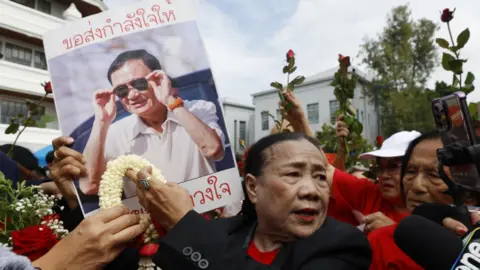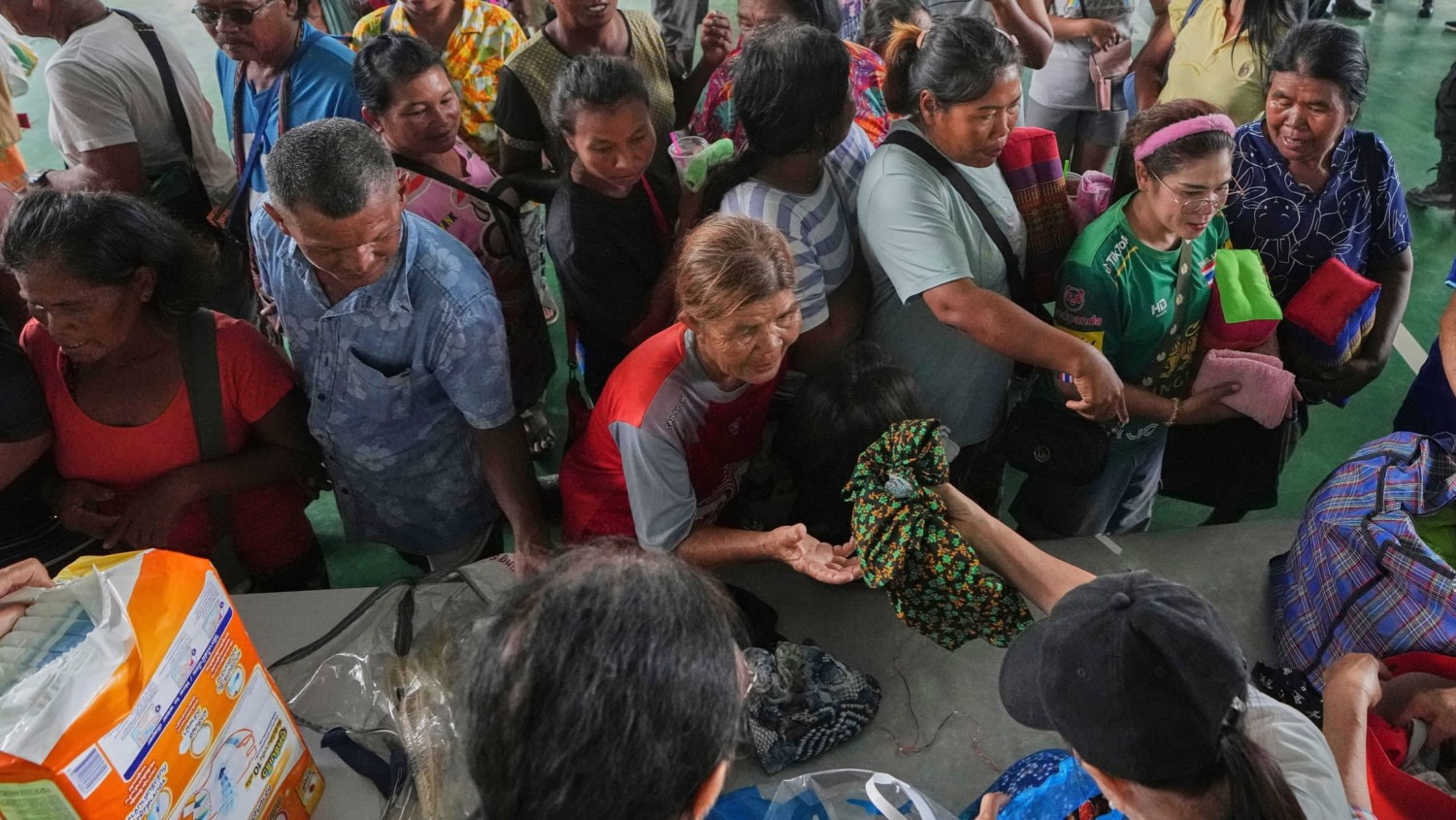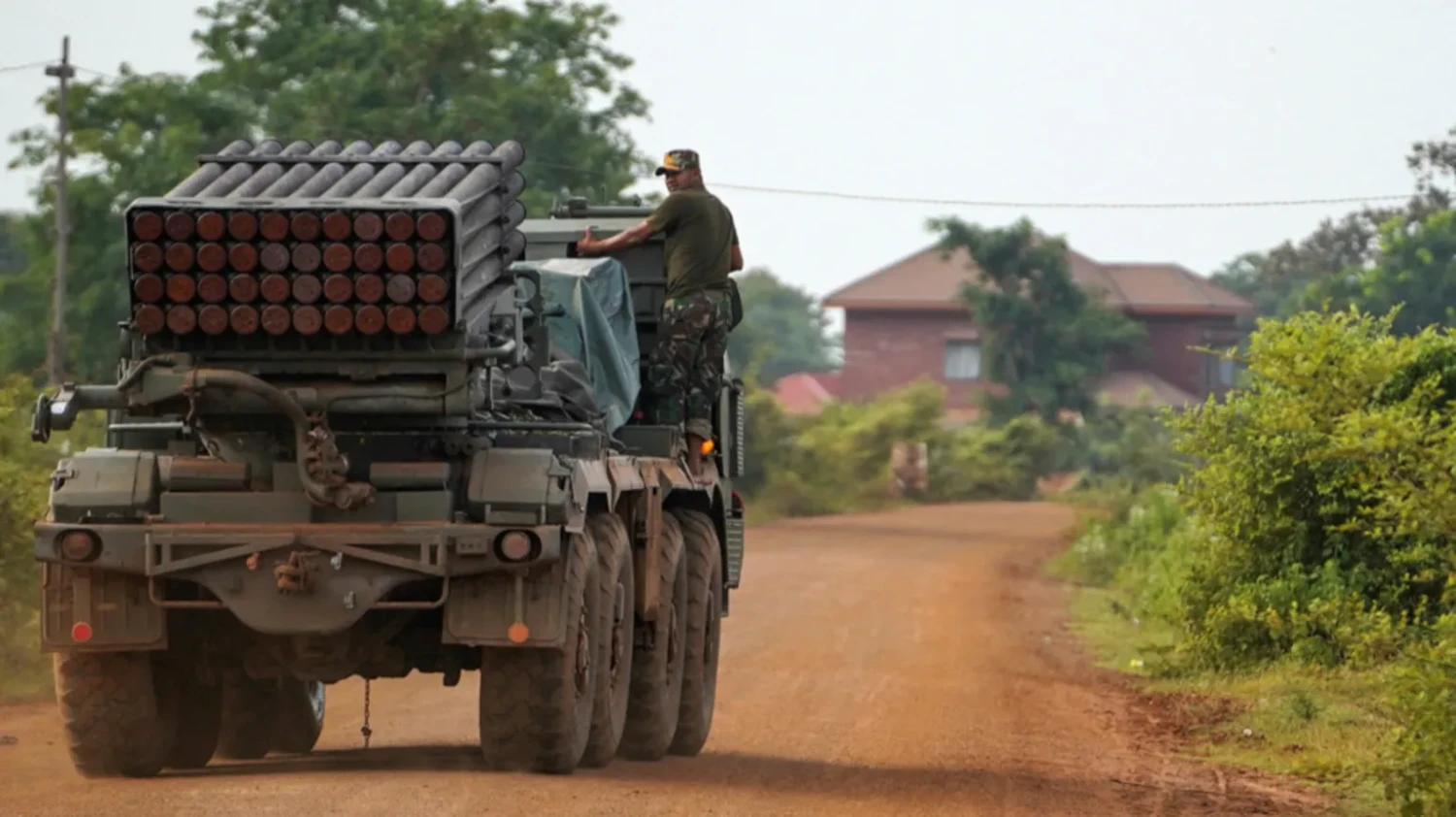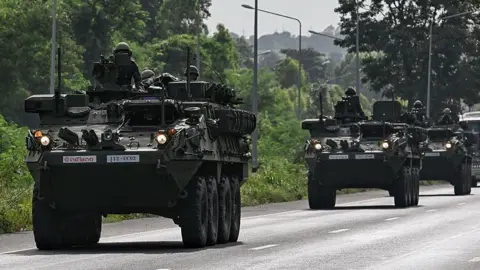
This article is more than
7 year oldFrantic rescuers battle against time to free Thai schoolboys from cave as one dies getting out
A FORMER Thai Navy SEAL who joined the rescue operation died on his way out from the cave complex after delivering oxygen tanks.
Thai authorities say the death was caused by a lack of oxygen inside the cave overnight, AP reports.
Rescuers continue to work day and night to save 12 Thai boys and their 25-year-old coach from the flooded cave before it’s too late, but some say they may be too weak to complete the terrifying mission.
Two of the boys and their football coach are suffering from exhaustion through malnutrition, which could make it almost impossible for them to attempt the perilous journey, a navy source told CNN.
It means rescuers could complete the mission in stages, with the boys who are well enough removed first and those that are too sick left behind.
The coach is believed to be in a bad way due to sacrificing his share of food to the boys, ABC reported.
A lack of oxygen and the approaching torrential rains also threaten to derail the risky plan to rescue the schoolboys.
They are trapped 3km into a system of linked chambers in Mae Sai, northern Thailand, as their frightened families wait at the cave entrance. It is believed they may have entered as part of an initiation rite, although two mothers came forward to say they did not blame coach Ekkapol Chantawong for their boys’ desperate circumstances.
The 25-year-old coach and former monk is struggling after selflessly sacrificing his share of food, reported the ABC. But it is still possible he could be charged over the crisis.
First, the global rescue operation urgently needs to get the boys out.
Skilled cave divers are painstakingly teaching them to swim in preparation for a perilous escape, which involves pairing them with trained frogmen and leading them to safety through pitch-black water and narrow passageways.
Officials confirmed members of the team have started to learn to scuba dive, and some parts of the journey will be walkable.
It had been hoped the rescue would begin on Thursday, but the ambitious plan remains on hold as fears grow for the group.
Rescuers say they have to get the boys out within 48 hours before the rains hit.


An anonymous navy source told the ABC three factors were driving the urgency — the water level inside the cave, the amount of oxygen available, and the health of the boys and their coach.
He said rescue co-ordinators faced “tough choices” and differences of opinion were emerging.
Australian Defence Force and Australian Federal Police have been tight-lipped about whether to attempt an extraction or wait, even until the end of the rainy season around October.
The navy source said boys’ biggest challenge would be a 200m stretch of completely flooded cave that made up part of the 600m section between “Pattaya Beach” and Chamber Three.
A firefighter who has been working on draining the water said levels in parts of the passage leading to the chamber were still flooded all the way to the ceiling, making diving the only way out.


VOLUNTEERS’ DANGEROUS WATER ERROR
Out in the open air, teams from across the world are working frantically with Thai authorities to overcome potentially deadly challenges and save the boys’ lives.
Time is not on their side, with torrential monsoon rains forecast to hit Chiang rai province this weekend, which could cut off the boys from the outside world for months.
Volunteers have been helping Thai Navy SEALs to pump water out of the caves, but some unregistered helpers made the situation worse by accidentally pumping water back into the cave, officials told the Bangkok Post.
Operation commander Narongsak Osotthanakorn said the volunteers directed the flow of extracted water into the ground, creating a stream that fed back into Tham Luang cave.
Mr Narongsak
“We are racing against water,” said Mr Narongsak, former governor of Chiang rai province. “Water is flowing into the cave although we have plugged its channels.”
Mr Narongsak has given the most detailed description yet of preparations.
“This morning, I have asked for 13 sets of equipment to be prepared and to check the equipment lists and place them inside in case we have to bring them out in this condition with less than 100 per cent readiness,” said Mr Narongsak at a media briefing.
“For example, if we can accept the 90 per cent safety level, and if all conditions are at that 90 per cent, then we are ready to bring them out. And that’s what we are prepared for.”
Belgian cave diver Ben Reymenants, who owns a business in Phuket, was reportedly exploring a new, wider channel with air pockets that could offer a safer route out for the boys.
If one of them was to panic while following a rope through water like “black coffee”, they could kill themselves or their rescuers.


SPACE EXPLORATION TECHNOLOGY COULD SAVE THEM
Elon Musk has offered to help hone in on the boys’ exact location. Representatives for the Tesla chief executive said they were in talks with Thai authorities about helping in the rescue.
Space Exploration Technologies (Space X) or Boring Company technology would pump water or provide heavy-duty battery packs known as Tesla Powerwalls but it’s unclear whether Thai officials will accept the offer.
In recent days Musk has put forward possible ways his companies could help.
“I suspect that the Thai govt has this under control, but am happy to help if there is a way to do so,” he wrote on Twitter.
Last year, the Puerto Rico government asked Musk to help after a devastating hurricane hit, with Tesla sending Powerwalls and providing advice on rebuilding the Caribbean island’s infrastructure.
Boring, Musk’s tunnelling start-up, could potentially make available its massive drills or excavation expertise, but such an approach could be too dangerous for this mission.

POTENTIALLY FATAL DELAY
The distraught families of the young boys are waiting and praying at the cave mouth for news of their children. The youngsters, aged 11 to 16, were believed dead after they went missing on June 23. They were finally found alive almost ten days later by divers on Monday, starving yet overjoyed to be discovered.
But their relatives have learnt the rescue operation could take weeks or even months if the storms arrive, and there is no easy way to extract the trapped boys from their subterranean prison.
Royal Thai Navy SEALs, Australian Federal Police divers and rescuers from countries including the UK, US and China have converged on the scene to help — but they are concerned at the slowness of communication.
It takes even experienced divers six to seven hours to complete the round-trip from forward command in the third cave chamber to the boys huddled on a ledge deep inside the complex at Noem Nom Sao. This could mean a fatal delay if anything was to go wrong during the audacious rescue plan.
Engineers are working to install a cable to allow the children to speak to rescuers and their families to improve their morale. Media at the scene reported seeing officials taking old-fashioned military communication devices into the cave system, but one phone reportedly fell into the water and had to be replaced.
Rescuers have also been transporting food, supplies and first aid into the caves, along with diving equipment to be used by the boys and oxygen “stage” tanks that will be set up every 25 to 50 metres along their route for extra air.
The boys have been practising wearing scuba masks, and will be kitted out with wetsuits, aqua boots and a helmet as they attempt to escape.
They will share oxygen from a navy rescue diver’s air supply as they follow a guide rope through the murky water.
The divers will have to remove their scuba kits to squeeze through certain narrow points along the route, with volunteers holding the guideline submerged up to ten metres at various points in the freezing, muddy water.
British cave expert Vern Unsworth, who lives in Thailand, said conditions were getting worse and there was now a narrow window in which the group could escape.
“I think we’ll know in the next 24 hours … We’ll keep our fingers crossed, everybody needs to pray and hope for a good outcome,” Mr Unsworth told the BBC.


HIDDEN PASSAGE OR A DEATH-DEFYING JOURNEY
Around 30 teams of jungle trekking rescuers were scouring above ground for a possible “secret passage” to safety, after the boys told divers they heard dogs barking, a rooster crowing and children playing.
If they weren’t hallucinating, this may mean the trapped boys are close to a shaft that rescuers could climb down for a far easier evacuation method.
The current plan involves an arduous, four-hour journey for the young boys, and could last for two days of continuous individual trips.
A certified cave diver from the US said the boys would have to undergo “intensive training” if they were to stand any chance of exiting the cave alive. “Normal cave diving requires skills that go beyond what 99 per cent of the world’s divers have ever seen, which is why it is so very hard to become certified to dive in caves,” John Adsit wrote in an educational journal.
“The greatest enemy to a diver is panic. Students who are accustomed to the normal mishaps of swimming, like accidentally getting water in the mouth or eyes, will usually have no trouble, but for people with little swimming experience, such a minor event can lead to irrational panic.

“Most of the Thai team members are nonswimmers, and the culture there has a common belief that swimming is extremely dangerous. That starts any training in a serious deficit.”
Classmates of the boys joined their families in the forest at the entrance to the cave, the BBC reported, where they sang: “Believe in God. Only belief can move a mountain.”
Soldiers were controlling the crowds as heavy machinery was brought to the cave entrance and medics rehearsed carrying empty stretchers to ambulances for when the boys emerge.
It is suspected that the group entered the cave to write their names on the wall as part of an initiation ritual. But Thai police refused to comment on whether the 25-year-old coach should be charged for leading the children into the cave.
Video shot by divers showed the boys looking thin but apparently in good spirits, asking what day it was and whether they could have something to eat.
Chilean miner Mario Sepulveda, who was trapped underground for 69 days in 2010, sent a heartfelt video message to the boys, telling them they should not be afraid to cry.
They will need to show even more bravery in the days to come.

WORLD CUP TEAMS SEND WELL WISHES
English, Swedish and Japanese soccer players competing in the World Cup are sending messages of hope to the boys after a rescuer filmed one of the boys wearing an England jersey. England defender John Stones said, “we’re hoping and wishing that they get out safe and sound.”
He added that, “everyone, their friends and families, all of the boys (here), all the England squad, all our thoughts are with them.”
Sebastian Larsson, on the Swedish team that faces England in a quarterfinals match Saturday, also hoped for good news, saying “all you can do in any situation like that is just pray for them.”
The Japanese squad that competed at soccer’s World Cup in Russia also tweeted a good-luck message. The message said: “Don’t give up! Hang on!” and in English “Hang on! Football Family are with you.” A Thai navy SEAL who has spent time with the boys in the cave has said they asked about the World Cup results.

— Additional reporting AP




